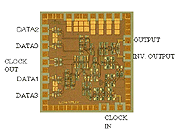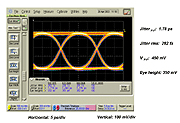Archived content
NOTE: this is an archived page and the content is likely to be out of date.
Fujitsu Develops Ultra-Low-Power Transceiver Chipset for Next-Generation Optical Transmissions Systems
World's First 50-Gbps Operation of a 4:1 Multiplexer and 1:4 Demultiplexer chipset at less than 1 watt
Fujitsu Laboratories Ltd.
-
[1] InP-HEMT
Indium Phosphide-based High-Electron Mobility Transistor A field-effect transistor that utilizes the rapid migration (compared to that within conventional semiconductors) of electrons that appear at the joint between semiconducting materials with different band gaps. Using Indium Phosphide in the substrate serves to accelerate the speed of the electrons.
-
[2] multiplexer
A circuit that combines multiple low-speed signals into one high-speed signal, based on time slices. When used in the transmitter of an optical signal, it is particularly important to have high-quality signals with little jitter (irregularity along the time axis).
-
[3] demultiplexer
A circuit that takes one high-speed signal that has been multiplexed from other signals and breaks it into its constituent parts. When used in the receiver of an optical signal, wide operation margins (clock phase margins) are necessary between the data signal and clock signal timings, to enable processing of data signal waveforms that may become corrupted when transmitted over long distances.
-
[4] full-rate clocking
Running the circuit using a clock signal frequency equivalent to the data bit rate is referred to as "full-rate clocking." Running the clock at one-half the data rate is referred to as "half-rate clocking." For example, 40-Gbps circuits that use a 40GHz clock are called a "full-rate clocking" circuit, while those that use a 20GHz clock are called a "half-rate clocking" circuit. Full-rate clocking circuits offer the benefits of low-jitter, high-quality signal processing.
-
[5] WDM
Wavelength-Division Multiplexing This technique enables multiplexing of multiple optic signals to one fiber-optic cable by incorporating multiple optic wavelengths that carry the signals. By utilizing the non-interfering nature of optic beams with each other when they have different wavelengths, a greater number of beams can be multiplexed together, thereby enabling a vast increase of data volume that can be carried over the fiber-optic cable. Recently, it has become possible to multiplex over 40 waves with this method, known as dense wave-division multiplexing (DWDM).
About Fujitsu Laboratories Ltd.
Founded in 1968 as wholly owned subsidiary of Fujitsu Limited, Fujitsu Laboratories Limited is one of the premier research centers in the world. With a global network of laboratories in Japan, China, the United States and Europe, the organization conducts a wide range of basic and applied research in the areas of Multimedia, Personal Systems, Networks, Peripherals, Advanced Materials and Electronic Devices.
For more information, please see: www.labs.fujitsu.com/en/
Technical Contacts
High-Speed IC Technologies Lab.Photonics & Electronics Lab.
![]() Phone: +81-46-250-8244
Phone: +81-46-250-8244
![]() E-mail: mux_demux@ml.labs.fujitsu.com
E-mail: mux_demux@ml.labs.fujitsu.com
Company:Fujitsu Laboratories Ltd.
All company/product names mentioned may be trademarks or registered trademarks of their respective holders and are used for identification purpose only.
Please understand that product prices, specifications and other details are current on the day of issue of the press release, however, may change thereafter without notice.
Date: 17 February, 2004
City: Kawasaki
Company:
Fujitsu Laboratories Ltd.,
,
,
,
,

